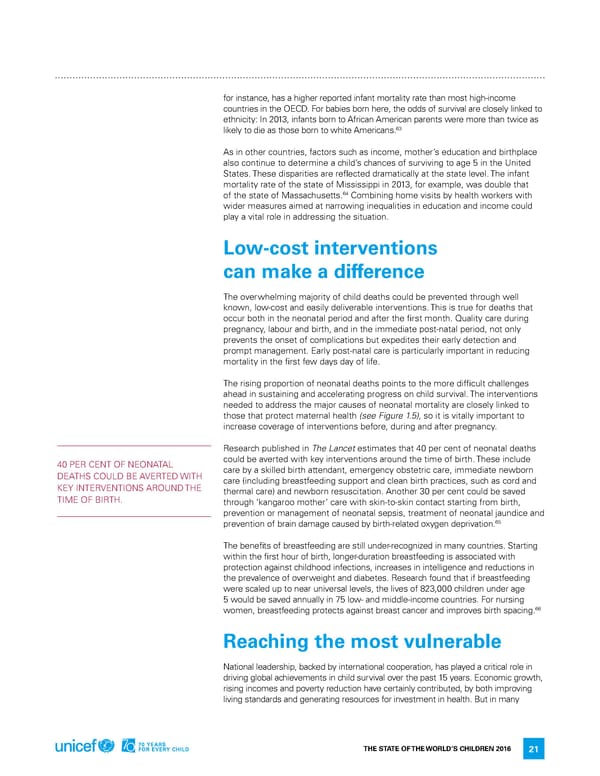for instance, has a higher reported infant mortality rate than most high-income countries in the oeCd. for babies born here, the odds of survival are closely linked to ethnicity: in 2013, infants born to african american parents were more than twice as 63 likely to die as those born to white americans. as in other countries, factors such as income, mother’s education and birthplace also continue to determine a child’s chances of surviving to age 5 in the United States. These disparities are reflected dramatically at the state level. The infant mortality rate of the state of Mississippi in 2013, for example, was double that 64 of the state of Massachusetts. Combining home visits by health workers with wider measures aimed at narrowing inequalities in education and income could play a vital role in addressing the situation. Low-cost interventions can make a difference The overwhelming majority of child deaths could be prevented through well known, low-cost and easily deliverable interventions. This is true for deaths that occur both in the neonatal period and after the first month. Quality care during pregnancy, labour and birth, and in the immediate post-natal period, not only prevents the onset of complications but expedites their early detection and prompt management. early post-natal care is particularly important in reducing mortality in the first few days day of life. The rising proportion of neonatal deaths points to the more difficult challenges ahead in sustaining and accelerating progress on child survival. The interventions needed to address the major causes of neonatal mortality are closely linked to those that protect maternal health (see Figure 1.5), so it is vitally important to increase coverage of interventions before, during and after pregnancy. research published in The Lancet estimates that 40 per cent of neonatal deaths 40 Per CenT of neonaTal could be averted with key interventions around the time of birth. These include deaThS CoUld Be aVerTed WiTh care by a skilled birth attendant, emergency obstetric care, immediate newborn KeY inTerVenTionS aroUnd The care (including breastfeeding support and clean birth practices, such as cord and thermal care) and newborn resuscitation. another 30 per cent could be saved TiMe of BirTh. through ‘kangaroo mother’ care with skin-to-skin contact starting from birth, prevention or management of neonatal sepsis, treatment of neonatal jaundice and 65 prevention of brain damage caused by birth-related oxygen deprivation. The benefits of breastfeeding are still under-recognized in many countries. Starting within the first hour of birth, longer-duration breastfeeding is associated with protection against childhood infections, increases in intelligence and reductions in the prevalence of overweight and diabetes. research found that if breastfeeding were scaled up to near universal levels, the lives of 823,000 children under age 5 would be saved annually in 75 low- and middle-income countries. for nursing 66 women, breastfeeding protects against breast cancer and improves birth spacing. Reaching the most vulnerable national leadership, backed by international cooperation, has played a critical role in driving global achievements in child survival over the past 15 years. economic growth, rising incomes and poverty reduction have certainly contributed, by both improving living standards and generating resources for investment in health. But in many The STaTe of The World’S Children 2016 21
 70 Years for Every Child Page 35 Page 37
70 Years for Every Child Page 35 Page 37